Affordability is often the single-most influential factor in choosing an overseas retirement destination. After all, who wants to spend their golden years counting pennies and wondering how far the next Social Security check will stretch? That’s the beauty of travel, and International Living’s Retirement Index—you have the power to choose a country with a cost of living that suits your budget.
This is not a subjective list. We’ve sent detailed surveys to our correspondents spread out around the world to get verified, specific costs for things like groceries; rent; utilities; household help; eating out; gym membership; transport and travel; and the unexpected costs that come with living overseas.
While an affordable location can mean more pocket money for leisure activities, it can also ensure peace of mind knowing you are financially secure and can live comfortably on a modest retirement fund. Below you’ll find the most affordable expat havens we’ve found, places where your dollars will get you further than in the U.S.
5. PORTUGAL
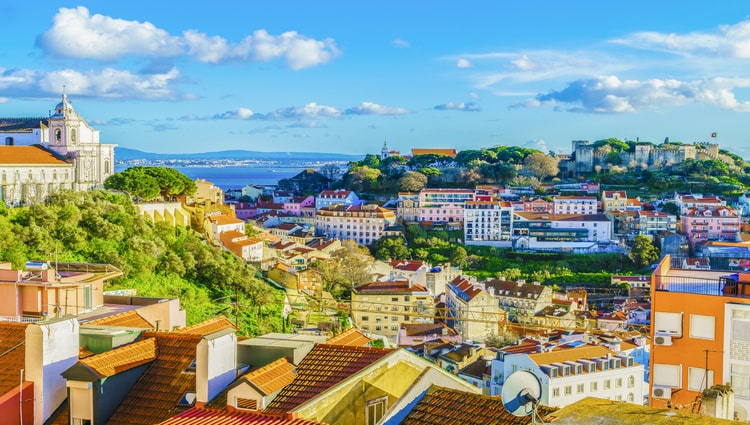
While most people think that living in Europe is out of their budget, the compact country of Portugal may surprise you. Foreigners from around the world have long known the charms of this Iberian gem that in recent years has been discovered by North Americans.
“The first time I mentioned visiting Europe to my husband Clyde he looked at me like I was crazy,” says Terry Coles, IL Portugal Correspondent. ‘Europe, people like us don’t go to Europe, only rich people can afford that.’ “Yet here we are, well into our fourth year of enjoying full-time living in Portugal and we are far from being considered rich.”
With exemplary healthcare, some of the finest in the world, at a fraction of what you would expect to pay back home, to boasting of being one of the safest countries in the world, life in Portugal offers first-world comforts for every budget. The highway system in Portugal is one of the finest in Europe, easy to navigate with ample rest stops along the way for food and drinks. Electricity is extremely reliable, high-speed fiber internet is available almost everywhere, tap water is delicious and drinkable and people of all ethnicities and skin tones rub elbows in harmony.
“In fact, people often think we are Portuguese since everyone here blends in, that is until we open our mouths and they realize that we are not fluent in their language,” says Terry Coles.
Healthcare costs are surprisingly low, yet the quality of care is equal to or even better than that in the U.S. Residents living in Portugal have access to both the public and private healthcare system, but most prefer to use the private system for the ease of choosing an English-speaking doctor and minimal wait times for appointments or procedures. Some average costs in a private hospital are, a bone density test €94, a colonoscopy €500, an emergency room visit €102, mammogram with ultrasound €166.
“This year my husband spent six days in a private hospital for post-COVID issues,” explains Terry Coles. “After being examined in the emergency room he was moved to a private room, kept on intravenous antibiotics the entire time, blood was drawn daily, a CT scan was performed, and he was provided a vegetarian diet of his choosing for a total cost of €1,400. After we submitted the bill to our insurance company our final cost was just €235, and his care was superb!”
Most expats live comfortably in Portugal on $2,500 a month, a bit more for coastal living and a bit less to live inland. Rent is typically the biggest part of this amount and can range from $400 in small rural communities to $1,000 or more in coastal towns. Expect to add another $100 or so for utilities, (electric, water, gas, trash), internet packages start around $37, and private health insurance for a couple starts around $100 but increases with age and type of policy.
Amy and Kristian Geiger estimate they live on one-third less in the coastal town of Burgau in the Algarve than they did in snowy Denver, Colorado. “Kristian keeps close track of our budget, and we live comfortably on $2,100 to $2,300 per month,” Amy explained. Their two-bedroom furnished apartment rents for less than $1,000 and is just steps from the beach. And like most American expats the couple are giddy at how little they pay in Portugal for medicine or to see a doctor. “What a shock it was the first time I purchased the medication Synthroid with a prescription,” Amy said. “The cost was just 30 cents for the same thirty-day supply that cost me $30 in Denver with a prescription and $150 without one.”
The buzzing café culture is alive and well throughout Portugal where locals and expats enjoy their morning cup of coffee and a delectable pastry for just a few euros. It’s perfectly acceptable to while away the hours with friends all afternoon sipping Portuguese wine for a mere €3 a glass. The wait staff will not encourage you to leave or even bring you the bill unless you ask.
When your tummy grumbles take advantage of the meal of the day at local eateries for €6 to €12 depending on location. Even in smaller towns, it’s possible to find an assortment of food from Indian, to Mexican, seafood, Thai, Chinese, Italian, vegan and more.
Housing costs throughout Portugal vary depending on location, proximity to the coast, furnished or not, size, number of bedrooms, and square footage. Rents inland in remote areas start around €350 for a two-bedroom, furnished older home. Newer, modern builds closer to the beach in a complex with a shared swimming pool and garage start around €600.
“I like to say that Portugal has something for every budget,” says Terry Coles. “Our first apartment was in a 40-year-old, private home, overstuffed with furniture and decorations from the 70s, yet the cost for this three-bedroom gem was just €350 a month. The apartment and location ended up being too cold for us, so we moved south to the Algarve. Our next apartment was modern, tastefully furnished but tiny, in a complex with a pool and garage, and the rent was €850 a month. Currently, we live in a spacious, two-bedroom, furnished new apartment within walking distance to everything and we pay €1,100.”
Portugal is home to over 500,000 foreigners who have succumbed to the charms of this beautiful, welcoming yet surprisingly affordable European hot spot.
Full Cost of Living in Portugal here.
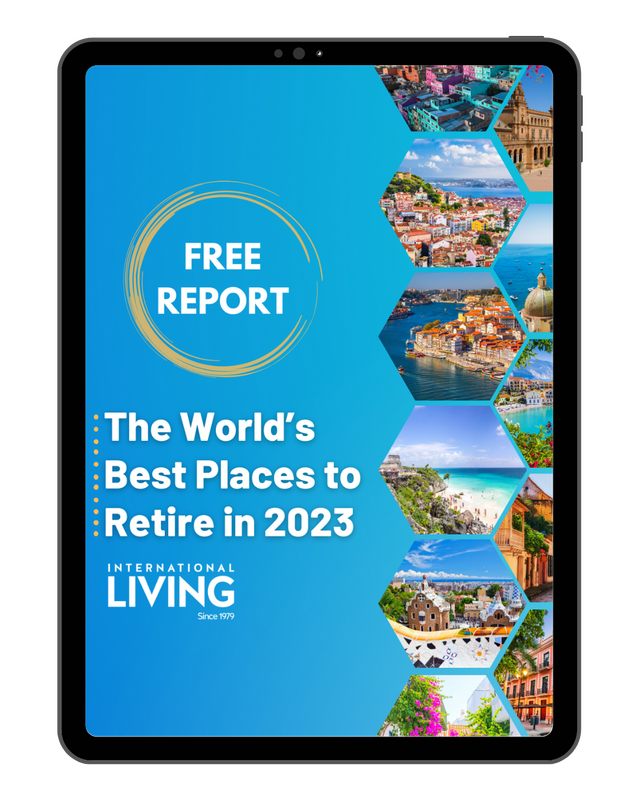
Get Your Free Report on the World’s Best Places to Retire:
Learn more about the best places in the world to retire in our daily postcard e-letter.
Simply enter your email address below to sign up for our free daily postcards and we’ll also send you a FREE report on The World’s Top 10 Retirement Havens, plus access to over 10 more free reports. Our gift to you, on our favorite destinations.
4. ITALY (tie)
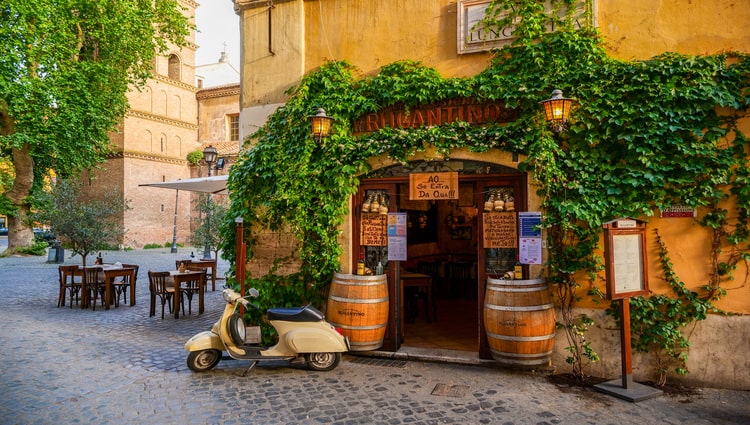
The widespread belief is that Italy is an expensive country to live in. This myth is exacerbated by hundreds of thousands of tourists who flock to well know Italian destinations: Venice, Rome, Florence, Naples, Milan, and Tuscany, and come home with tales of beauty, and expense. If you want to live like a tourist Italy is expensive.
But for the fifty million Italians who live in Italy year-round, outside of the tourist areas, Italy costs about half of what it costs to live in the U.S.
Living in the north is more expensive than living in the south or central areas of Italy and living in small towns is much less expensive than in large cities.
“As a general rule, rents in Italy are lower than rents in the U.S.,” says Chip Stites, IL Italy Correspondent. “We live just outside of Rieti in a 2300 sq. foot five-bedroom, three-bath home, with incredible views for $730 a month. Before we moved outside of the town, we were paying $415 a month for a three-bedroom, one-bath condominium.
“We have a lady, now a friend who comes in twice a week and spends six to eight hours helping us with our chores inside and outside the house. This costs us about $110 a month.
“Rent is the single most expensive part of the budget. Our home is heated with wood, solar, pellets, and natural gas. Filling up the liquid natural gas tank costs about $1650 and lasts depending on the weather about eight months with the pellets. There are three to four months in the summer that cost nothing as solar heat all the water we need.”
Italy’s healthcare system is routinely ranked among the best in the world. Though costs vary based on a number of factors including region and whether you have private insurance or not, expats report healthcare costs as reasonable.
“We pay $820 a year for the two of us,” says Chip. “If you compare our previous cost of $1,440 a month in the U.S. with a $6,000 deductible the savings is extremely high. Our insurance cost is fixed and as long as we live in Rieti it will stay the same.
Aside from housing costs, living expenses in Italy are fairly consistent around the country. You’ll always find upscale, expensive restaurants as well as budget-friendly, family-style eateries no matter where you go.
“Most of the food we eat comes from the Rieti Valley or an area that is within 10 miles of our home,” says Chip. “It is fresh, seasonal, and healthy with few preservatives and limited low shelf life.”
Living away from the bigger cities doesn’t mean sacrificing the quality of life, because even in provincial cities there are cultural events, historical sights, and an authentically Italian way of life.
“We live on about $3,500 a month, (depending on the exchange rate) most of which is paid by our Social Security check,” says Chip. “We spend around $1,095 a month doing things we want to do, seeing the sites, entertaining, eating out, and being with friends. But this area of expense is mostly pleasure and fun.”
Full Cost of Living in Italy here.
4. ECUADOR (tie)
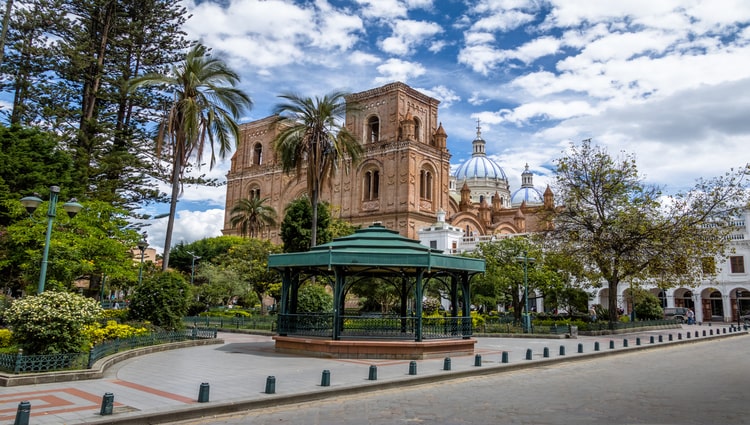
The low cost of living is the number one reason for many expats moving to Ecuador. It can be a tremendous advantage, particularly if you are on a fixed income. Rental prices are half the cost than in the U.S. or Europe, and often include furnishings. If you own, your property taxes will be a fraction of prices in the U.S., less than half of what you would pay. Local mercados offer fresh fruits and vegetables year-round, at prices so low you will not be able to carry what $20 will buy. You can live without heating or air conditioning in many areas, and even a car can be an optional expense.
“I live the same level of lifestyle in Cuenca as I did in the states. But in the states, I worked full time which left very little time for recreation. Here, I work two hours a day, teaching English and editing, and I’m able to enjoy the rest of my day. My rent, including utilities, is $400 per month. I pay my landlord in cash. I have no bills, no car payment, and nothing to worry about. My health insurance costs $55 per month. It’s automatically put onto my credit card. If I ever need to take a taxi instead of walking, it’s $1.50 or $2.00. Life here is beautiful. Every day, I just go with the flow,” says Maureen Seals, an expat who has lived in Cuenca for several years.
In Ecuador, not only can you retire on little money, but you can also live very well. A couple can comfortably retire on less than $18,000 per year. If you are single, you can live on $1,000 a month but it is important to remember that in order to get the most out of that low cost of living, you may need to make some changes to the way that you live now. Living on the outskirts of larger cities can cut your rental costs by a couple of hundred. Buying vegetables and meat from smaller tiendas or the large indigenous mercados are much cheaper and are probably also of much better quality than what you are used to. Modern supermarkets have higher prices, but carry American brand name products but you will end up spending more on your food budget.
In 2010, Jo Merriam was laid off from a company, which also eventually went bankrupt, depleting her pension and any promise of a financially stable future. After 3 ½ years of fruitlessly looking for new job, Jo decided to explore her lifelong dream of living overseas, studying her options of retiring in South America, and soon decided that perhaps moving abroad could be her financial solution. She settled in the small indigenous village of Cotacachi, Ecuador [population 8,000], located in the northern Andes mountains, just 45 minutes north of Quito (the capital of Ecuador), and rented a little casita for $250 and quickly made friends in the tight-knit community of 1,000 expats.
As for her life since leaving the United States, “My stress is down 95%. I can live a comfortable life on my social security of $1,000 a month with no problem. It’s not a luxury living, but it’s very similar to my life in the States. I’ve joined IESS [the government social medical program] which costs around $55 a month and I’m healthier here. In the States, the last 3 to 4 years I had no health insurance. I don’t do medications and there’s plenty of organic food so I eat healthier and walk a lot so I’ve lost 70 pounds without dieting,” adds Jo.
Jo is not a singular example. In 2019, the average retirement account savings for American households was $65,000 and the average monthly income was $2000, which leaves many boomers searching for ways to retire with limited budgets. As boomers reach retirement, living abroad is a viable solution to low-cost living.
Ecuador rose as an alternative for economic refugees because of what you don’t have to spend to live comfortably. You can live cheaply here as many towns are walkable and you don’t need a car because of the plethora of public transport: taxis run around $3.50 a ride to get most anywhere and public buses and the Tranvía top out at 35 cents per ride. There’s no need for heating and air conditioning because the weather is temperate most any place in the country. IESS, the government health program, will run you on as low as $84 for two people. And rents are as low as $250 in small coastal towns like Olon or Manta and mountain villages like Cotacachi. Rents start at $450 for larger more cosmopolitan cities like Cuenca [population 450,000], a resort city in the Andes, or Salinas [population 50,000], a popular coastal town.
Entertainment comes cheap too. You can grab an almuerzo (lunch) for $3 at small restaurants that cater to the locals which includes fruit juice, chicken, rice, and dessert. And restaurants serving international cuisine start at around $7 for lunch so you can grab your favorite Italian, Thai, Chinese or Mexican goods at a reasonable cost.
In Cuenca, there are many social groups you can join to explore your hobbies for photography, hiking, pickleball, and playing trivia or card games…for free. All over Ecuador, there are fiestas, countless parades, nightly fireworks, craft fairs and all types of free or low-cost entertainment on most weekends.
Additionally, the low cost of living in Ecuador allows retirees to increase their travel with a retirement benefit of 50% discounts on air fares but does not include taxes and tariffs. It is about the same price to fly internationally from Quito International Airport as it is from locations on the east coast of the U.S. And many cruise lines sail out of Argentina, so if Patagonia, Uruguay, or Chile are on your bucket list, travel agents in Ecuador can make those dreams come true.
If you are 65 or older it gets even better. Members of Tercera Edad, which means “Third Age” in Spanish enjoy many special benefits in Ecuador. Like half-price public transportation, discounted admission to sporting and cultural events, $1.50 bus rides to nearby cities and it’s only $12 to catch an executive comfortable bus for a four-hour ride from Cuenca to Guayaquil’s International Airport. Plus, you are eligible for a refund on what you spend for your monthly IVA tax on all purchases up to $96 a month.
“My total bills excluding rent and groceries only comes to $200 a month for electricity, internet, water and sewage, and IESS health insurance. I live off of $1,800 a month with enough savings left over to travel to visit my family in Florida two to three times a year. And still, have enough funds left over to plan an adventure vacation. Most recently my sister and I went hiking in the Grand Canyon,” adds Stiteler.
“If it wasn’t for Ecuador, I would still be working nonstop six days a week at my job in order to access healthcare with no end in sight. Now, I am free from counting pennies, and instead, just go out and have fun without the worry of making monthly expenses.”
Full Cost of Living in Ecuador here.
3. MEXICO
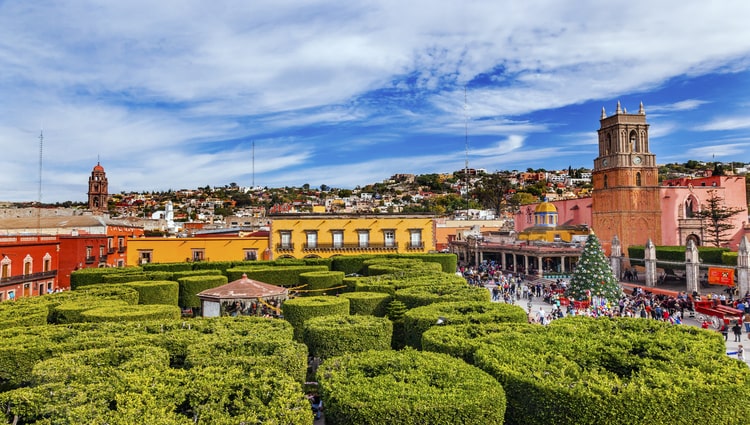
Mexico has something for everyone: funky towns and elegant resorts, hundreds of beaches, world-class diving and snorkeling, lush jungles, high-altitude deserts, snow-capped mountains, and beautiful Spanish colonial cities. Whether you like a warm climate with a constant sea breeze, a hot and dry semi-arid or desert climate, or you want to be somewhere cool enough that you’ll need to wear a jacket in the evenings year-round, Mexico offers unlimited choices.
It’s an excellent retirement destination for any budget, too. A typical monthly budget for two people, living a comfortable, middle-class lifestyle, will probably not exceed $2,000, and it’s certainly possible to get by spending a lot less than that, too.
American expat M’kali-Hashiki Nln, who lives in a furnished, two-bedroom apartment in the city of Oaxaca, says “I spend $800 to $900 per month…I could go cheaper if I lived in a different place or walked more and took fewer taxis.”
Mexican food is outrageously good; it’s one of the benefits of living here. Fortunately, you can easily find great, multi-course meals at sit-down restaurants for about $3 per person. These comida corrida (literally, “food on the run”) menus include soup or pasta, an entree with salad, rice and beans, tortillas or bread, a pitcher of the agua del diá (fruit-infused water of the day), and often a small appetizer or dessert. They’re delicious, and it costs less to eat out than it would to try to cook it yourself. Some restaurants even serve comida corrida meals featuring gourmet international cuisine; a lunch with all the accompaniments, with a choice of agua del diá or a craft beer, costs around $8. Even meals at fine restaurants, including a beer or nonalcoholic beverage, usually cost less than $20 per person.
As a general rule, if you live like a local, you’ll enjoy prices that seem unimaginably low. I know foreign women who pay $50 or more to have their hair done by hairdressers who specialize in expats. I go to a local hairdresser who barely speaks a word of English, and I always spend less than half that amount for a color, trim, and style; I’ve been consistently thrilled with the quality of her work. It’s the same for practically everything here—the locals know the best places; they don’t pay gringo prices. The longer you live here, the less you’ll end up spending as you make new friends, discover favorite places, and settle into your new home.
Healthcare is excellent throughout Mexico. Hospital-affiliated English-speaking physicians charge around $50 and follow-up appointments are often free. Specialists charge around $75. Physicians at consultorios—small clinics often associated with pharmacies—charge even less. X-rays cost around $25, CT scans cost less than $100, and an electrocardiogram costs a mere $3—no doctor’s appointment required. Dental work is also a bargain, and tens of thousands of Americans cross the border each year to save money on their teeth. Check-ups range from free to around $20, crowns cost $200 and up, and implants cost $700 to $1,000.
Mexico has two government-run healthcare plans. INSABI (Instituto Nacional de Salud para el Bienestar) is intended for low-income Mexicans and legal foreign residents. It costs nothing, though the care tends to be basic and the wait to get treated may be long. The IMSS system (Instituto Mexicano de Seguro Social) offers better healthcare to employees and those willing to pay to enroll; prices are on a sliding scale dependent on age, and range from around $400 to $700 annually. IMSS has some restrictions for preexisting conditions, with some chronic diseases either ineligible for coverage or requiring a waiting period of two or more years.
If you have private insurance, you’ll have access to the best hospitals in the country, and some of these are as good as you’ll find anywhere in the world. Mexico has several JCI-accredited hospitals and many others that offer English-speaking staff, state-of-the-art equipment, and top-notch care. Prices at these hospitals, like everything else health-related in Mexico, are less than half what the same services would cost in the U.S.
Real estate also costs less in Mexico than in the States. Foreigners can legally purchase property in Mexico. If you want to buy a home within 31 miles of the beach, or within 62 miles of an international border, you’ll need to establish a fideicomiso. With this instrument, the title of the property is held in a trust by a bank, but the bank does not own the property; you do, and you’ll have all the rights to use that property as you wish, whether it’s to live in, rent or sublet, improve, mortgage it, or leave it to your heirs.
Property taxes are low here—only 0.1% of the assessed value. Places near the beach tend to cost more than those located in inland areas, but even these would be far less expensive than comparable homes by the beach in the U.S. Modern condominiums and houses in move-in condition start in the low $100,000s even in some coastal areas; for around $200,000, you’ll find an abundance of luxury homes in the Riviera Maya and in other prime locations throughout the country.
Labor costs less in Mexico than it does in the States. Hiring a housekeeper or gardener is an affordable luxury here. Wendy Justice, IL’s Mexico Correspondent, says, “I pay my housekeeper, who comes once a week, $60 per month plus a $10 tip; it takes her about four hours each time. She’s honest and dependable, does a wonderful job, and she’s quite happy with her salary.” Prices will vary depending on where you live, but it’s unlikely that you would pay more than $200 per month for twice-weekly housecleaning.
Full Cost of Living in Mexico here.

Get Your Free Report on the World’s Best Places to Retire:
Learn more about the best places in the world to retire in our daily postcard e-letter.
Simply enter your email address below to sign up for our free daily postcards and we’ll also send you a FREE report on The World’s Top 10 Retirement Havens, plus access to over 10 more free reports. Our gift to you, on our favorite destinations.
2. THAILAND

The popular and colorful South East Asian country of Thailand provides such affordable living that even upscale experiences are bargains for the taking. Thailand, nestled between Myanmar, Laos, and Cambodia, also shares a border with Malaysia and provides a history and culture that is as unique as it is old.
Expats are sprawled happily across many provinces as this diverse country offers a myriad of retirement lifestyles and can provide affordable experiences on most budgets. The beaches and islands offer an idyllic retirement for lovers of the water, happy views, and water sports. Bangkok, known as Krung Thep by the local people, is perfect for people who are looking for a more cosmopolitan life filled with fashion, tech gadgets, and bustling nightlife. Northern Thailand is filled with blissful mountains, acres of rice fields, and an amalgamation of Thai, Burmese, Laos, and Cambodian cultures.
Deciding between tall condo apartments, old traditional style housing, or cheaper studio condos will be easy and you’ll be spoiled for choice. A modern one-bedroom apartment in trendy Sukhumvit, Bangkok close to restaurants and nightlife will only set you back $626 per month. If you are looking for something with more space a three-bedroom villa within a close range of the beach on Koh Samui is an affordable $475 per month. For those looking for absolute value for money, you cannot go past Chiang Mai where rents are probably the cheapest, a city studio with a kitchenette can be as little as $184 but you don’t have to feel suspicious of the cheap prices, these studio apartments are clean and to a western standard.
Many expats immerse themselves in the food culture of Thailand. Restaurants come in many shapes and forms from revolving skyscrapers to plastic stools on the sidewalk, but all promise exquisite culinary experiences as cooking fresh food daily is deeply embedded into Thai culture. Fragrant and spicy street food can be as little as $1.72.
Alternatively, if you are wishing to spend more, or enjoy a more decadent experience, you can eat at a Michelin-star restaurant in Bangkok for under $50. If Asian food is not your style, no problem as there are many western options. A hamburger and chips are only around $5.20 and a ten-inch pepperoni pizza will be under $7.
“I spend about $150 a month on household groceries. But if I go out I tend to eat Thai which can be as little as a few dollars,” says expat Ronni Kerrins of her food budget.
Although, the coffee culture has grown exponentially over the last decade and the country offers thousands of coffee places to meet with friends. A latte on average is only $1.30 and often a display of cakes and pastries will be on display to tempt you for as little as $2.60.
Already famous for health tourism, Thailand offers first-rate hospitals and health services. All specialists are English speaking and many have even trained in America or England. Bangkok hospital, which has hospitals all over Thailand, tries specifically to create deals for expats for annual health checks. An initial visit to a specialist will barely dent your wallet as it will only cost around $10. Bangkok hospital almost seems like a luxury hotel with sparkling tiled floors, freshly painted walls, state-of-the-art technology, and tasteful artwork. At the other end of the health spectrum, one night in intensive care is around $2000 in the north of Thailand. You will also be smiling about the dentists in Thailand as a filling begins at $30 and root canal work will probably be under $200.
A surprising aspect of life in Thailand is its transport system. The trains in Bangkok are efficient and reliable and they also offer a cheaper travel alternative to other parts of the country like Hua Hin and Chiang Mai. The roads throughout the country are also in very good condition and you can find a car rental for around $30 a day. These safe highways can lead you to ancient ruins in Ayuttaya, south of Bangkok, or to the town of Mae Sai, where you can walk over the border to Myanmar (Burma). A local taxi ride of around 40 minutes depending on traffic is only $8 so where ever you want to go, you will be able to get there without worrying about the cost. Of course, if you have the skills a brand-new Honda motor scooter is a steal at around $1300.
Often new expats are searching for the magic number the cost of living, but it depends on so many factors. “A good quality lifestyle here costs around $2,000 per month,” says experienced expat David Lucero.
“Although, you may be surprised to find that sometimes things are free in Thailand,” says Rachel Devlin, an IL contributor living in Chiang Mai. “Recently, when looking at a temple I was offered water and snacks by a kindly monk in his saffron-colored robes. When thinking about it, beautiful Thai smiles are everywhere and they don’t cost a cent.”
Full Cost of Living in Thailand here.
1. COLOMBIA
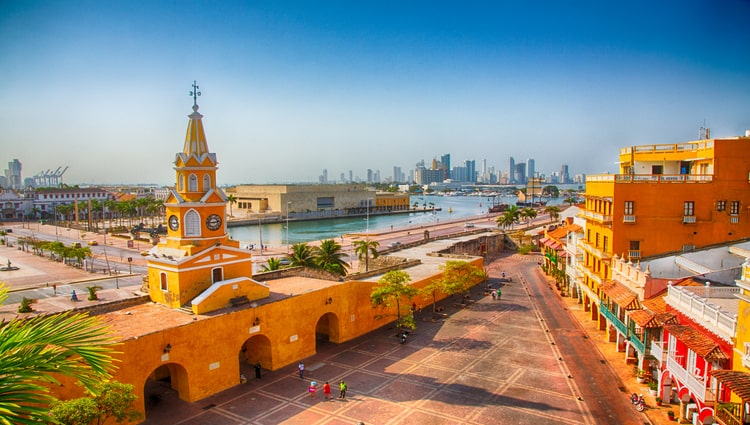
One of the main benefits of living in Colombia is the low cost of living. And what’s more, it’s a low cost of living in a country that offers many of the first-world amenities and infrastructure that you’d expect in a much more expensive location.
“Colombia is seeing a wave of newcomers like never before,” says Erin Donaldson. “They are coming here because even with the current inflation the cost of living in Colombia is still much lower than in most of their home countries.
While the cost of living has risen considerably in recent years, foreign residents can still live quite comfortably in upper-class areas starting at $1,000 per month for small cities like Manizales and Pereira, and $2,000 per month for larger cities like Bogota and Medellin.
It is important to note that Colombia uses a tiered, estrato system to determine the cost of utilities, including electricity, natural gas, water, and telephone and internet service. The system assigns an estrato number to neighborhoods based on the average income of its residents. Lower estrato neighborhoods pay lower rates than higher estrato neighborhoods.
In bigger cities like Medellin and Bogota rents can start around $1,000 per month for a nice area. Smaller cities like Cali, Pereira, and Bucaramanga will see prices starting closer to $500 per month.
“Expect to pay at least $100 for monthly utilities in strata 5 or 6,” says Erin. “Especially in bigger cities like Bogota and Medellin. This would be natural gas, electricity, and, water. Internet and TV services will start around $20 or $30 per month and can be as much as $50 or $100.
“Food is going to be dependent on your dietary needs, preferences, and whether you cook at home or go out to eat. In a small town, coffee can cost you $0.20+ per cup. In a big city, expect to pay at least $1 for a decent quality black coffee, or half if you are drinking low-grade commercial brew.
One person living at strata 5,6 will spend at least $300 per month if they eat out once a day, and go out on weekends. A typical lunch runs around $4 for soup, a main plate (meat/rice/salad), and a drink. Fancier restaurants will cost around $10 per person for a meal.
It is now 100% obligatory to have travel health insurance to enter Colombia as a tourist, visitor (student), or migrant (retiree). Costs depend heavily on age, income, and the type of insurance you need.
Colombia does have Foreign Medical Program Veterans Administration benefits recognition. There’s a VA Representative in Medellin who can assist. 100% of disabled veterans get all medical needs paid in full, and the partially disabled receive payment for things related to the disability.
EPS insurance is government-subsidized work-based healthcare that can cost as little as $50 for an independent. The other, more private health insurance companies will be based on age and income.
“Colombia has a great variety of activities for your free time,” says Erin. “Most classes for learning a new hobby, dance, instrument, or even sport will start around $10 to $20 per hour for personalized classes in the bigger cities, and $10 to $20 per month for group classes depending on strata and quality.
“Beer starts at $1 per bottle for national brews in a small corner tienda and $2 to 3 in strata 5 or 6. A bottle of rum/aguardiente starts at $7 from a shop and $15 at a bar.
“Cinemas are also popular in Colombia but typically only have English-language movies on a Monday or Tuesday during the week. Contact the local venues in your city of choice to find out what day exactly. The average movie ticket starts at $3.”
Full Cost of Living in Colombia here.

Get Your Free Report on the World’s Best Places to Retire:
Learn more about the best places in the world to retire in our daily postcard e-letter.
Simply enter your email address below to sign up for our free daily postcards and we’ll also send you a FREE report on The World’s Top 10 Retirement Havens, plus access to over 10 more free reports. Our gift to you, on our favorite destinations.
Related Articles
The World’s Best Places To Retire
Your Overseas Retirement Calculator
Upcoming Conferences
The Only 2024 Fast Track Panama Conference
If your dream retirement involves stunning beaches… lush green mountains… a warm climate with no hurricanes… first-rate healthcare… incredible value for money (a couple can live well on $2,200 a month)… and the World’s #1 Retiree Discount Program…
Join our Panama experts and expats in February and discover why Panama could be your perfect paradise.
REGISTER NOW, SEATS LIMITED: EARLY BIRD DISCOUNT HERE



.png)